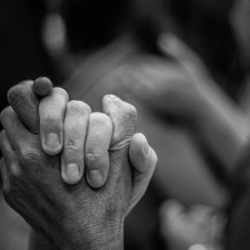Welcome readers! Please subscribe through the buttons at the right if you enjoy this post.

“But I tell you, do not resist an evil person. If anyone slaps you on the right cheek, turn to them the other cheek also. And if anyone wants to sue you and take your shirt, hand over your coat as well. If anyone forces you to go one mile, go with them two miles. . . .
I tell you, love your enemies.”
— Jesus (Matthew’s gospel)
Jesus never taught passive nonresistance. Nor did he teach survivors a path of self-sacrifice. Yet when we read the above quotation from Matthew’s gospel from our own context, it sure sounds like he did. Jesus taught his followers the difference between violent retaliation and nonviolent resistance. While some interpret this passage to teach passive nonresistance, I believe it teaches us nonviolent resistance. There is a huge difference between the two.
I am indebted to the late scholar Walter Wink for his insights and cultural research on this section of Jesus’ teachings, especially in the book Jesus and Nonviolence: A Third Way (Fortress, 2003). Wink is dearly missed and his influence will long continue.
Not only did Jesus teach the theory of nonviolence. He also gave us real-life examples of how to apply it and modeled his teachings throughout his entire life.
In Matthew, Jesus says:
“If anyone slaps you on the right cheek, turn to them the other cheek also.” (Matthew 5:39)
What did this mean? In Jesus’ culture, the use of the left hand in interpersonal interactions was strictly forbidden. Since most people are right-handed, they only used the left hand for unclean tasks. To even gesture at another person with the left hand carried the penalty of exclusion and ten day’s penance (see Martínez, Florentino García, and Watson in The Dead Sea Scrolls Translated: The Qumran Texts in English [2007], p. 11). Therefore, one would not hit someone’s right cheek with the left hand.
One would also never strike an equal on the right cheek. A blow between equals would always be delivered with a closed right fist to the left cheek of the other. The only natural way to land a blow with the right hand on someone’s right cheek was with a backhanded slap. This kind of blow was a show of insult from a superior to an inferior—master to slave, man to woman, adult to child, Roman to Jew—and it carried no penalty. But anyone who struck a social equal this way risked an exorbitant fine of up to 100 times the fine for common violence. Four zuz (a Jewish silver coin) was the fine for a blow to a social peer with a fist, but 400 zuz was the fine for backhanding them. Again, to strike someone you viewed as socially inferior to yourself with a backhanded slap, was perfectly acceptable (see Goodman in Jews in a Graeco-Roman World [2004], p. 189). A backhanded blow to the right cheek had the specific purpose of humiliating and dehumanizing the other.
What did Jesus command the dehumanized victim to do? A retaliatory blow would only invite retribution and set in motion escalating violence. Instead, Jesus told us to turn the other cheek, the left cheek, to the supposed superior to be stricken correctly—as an equal. This would demonstrate that the supposed inferior refused to be humiliated, and with the left cheek now bared, the striker would be left with two options—a left-handed blow with the back of the hand (and its penalty) or a blow to the left cheek with a right fist, signifying equality. Since the first option was culturally not an option and the second option would challenge the striker’s supposed superiority, the aggressor lost the power to dehumanize the other.
For someone attacked in this way, turning the other cheek would be an act of nonviolent resistance.
Next, we read:
“And if anyone wants to sue you and take your shirt, hand over your coat as well.” (Matthew 5:40)
A court of law constituted the setting for this injunction from Jesus. Many of the very poor of his day had only two articles of clothing to their name. The law allowed a creditor to take either the inner garment (chiton) or the outer garment (himation) from a poor person as a promise of future payment if they lacked means to pay a debt. However, the wealthy creditor had to return the garment each evening for the owner to sleep in:
“If you lend money to one of my people among you who is needy, do not treat it like a business deal; charge no interest. If you take your neighbor’s cloak as a pledge, return it by sunset, because that cloak is the only covering your neighbor has. What else can they sleep in? When they cry out to me, I will hear, for I am compassionate.” (Exodus 22:25–27)
“When you make a loan of any kind to your neighbor, do not go into their house to get what is offered to you as a pledge. Stay outside and let the neighbor to whom you are making the loan bring the pledge out to you. If the neighbor is poor, do not go to sleep with their pledge in your possession. Return their cloak by sunset so that your neighbor may sleep in it. Then they will thank you, and it will be regarded as a righteous act in the sight of the LORD your God.” (Deuteronomy 24:10–13)
“Do not deprive the foreigner or the fatherless of justice, or take the cloak of the widow as a pledge.” (Deuteronomy 24:17).
In that society, before the invention of modern underwear, it was more shameful to look upon someone’s nakedness than to be naked. Remember Noah’s son Ham?
“Ham, the father of Canaan, saw his father naked and told his two brothers outside. But Shem and Japheth took a garment and laid it across their shoulders; then they walked in backward and covered their father’s naked body. Their faces were turned the other way so that they would not see their father naked.” (Genesis 9:22-23)
Because of this context, a debtor stripping off their chiton (if the creditor was suing for the himation) or their himation (if the creditor was suing for the chiton) in public court would turn the tables on the wealthy creditor and put the poor person in control of the moment. Compare Matthew 5:40 and Luke 6:29: “If anyone wants to sue you and take your shirt [chiton], hand over your coat [himation] as well” (Matthew 5:40). “If someone takes your coat, [himation] do not withhold your shirt [chiton] from them” (Luke 6:29).
A debtor exposing their body would also expose the exploitative system and shame the wealthy and powerful person who took the last object of value from them. Here, Jesus was endorsing public nudity as a valid form of nonviolent protest or nonviolent resistance. It was an act of protest, and nonviolent: Jesus recommended nakedness in protest over returning violence with more violence.
The third example of nonviolence that Jesus gives is:
“If anyone forces you to go one mile, go with them two miles.” (Matthew 5:41)
Roman law allowed soldiers to conscript at will those occupied and require them to carry burdens for up to one mile. This limit provided some protection for the occupied people. But if one followed Jesus’ words and cheerfully carried a burden beyond the required first mile, it put the soldier making the requirement in the awkward position of not complying with the limit imposed by his superior. As a result, the soldier could end up being disciplined if the situation were made known. Imagine the discussion between the Jewish Jesus follower and the soldier, who was a representative of the Roman power deeply despised by the Jewish people, for the entire second mile. Going the second mile would have placed the Jewish subservient in a position of power and held the soldier’s attention.
In these cases, Jesus’ instructions were not commands of passive nonresistance; they were ways of putting nonviolent resistance into practice, enabling the oppressed to affirm their selves or their humanity, and place them in a certain position of power. Gandhi once said that Jesus, “has been acclaimed in the west as the prince of passive resisters. I showed years ago in South Africa that the adjective ‘passive’ was a misnomer, at least as applied to Jesus. He was the most active resister known perhaps to history. His was non-violence par excellence.” (in Gandhi and Prabhu. What Jesus Means to Me [1959], p.18.)
Now let’s turn back to the phrase found at the beginning of these three examples in Matthew’s gospel:
“I tell you, do not resist an evil person.” (Matthew 5:39)
The Greek word translated into English as “resist” in this verse is anthistemi, which means to answer violence with violence, evil with evil, like for like, an eye for an eye. “Do not retaliate” is a far better translation. The Scholars Version of the Bible translates Jesus’ words as, “Don’t react violently against one who is evil.” The context of the statement makes clear that Jesus was teaching non-retaliation: “You have heard that it was said, ‘Eye for eye, and tooth for tooth.’ But I tell you. . .” Don’t let evil spread! Don’t add more death to death. Stand up against death by refusing to let go of life, by turning the other cheek, stripping down to nakedness, refusing to only go one mile!
Yes, Matthew’s Jesus was teaching a rejection of violent responses to this world’s evil. Yet he was not teaching that we should simply do nothing! Jesus was teaching nonviolent ways for oppressed people to take the initiative, to affirm their humanity, to expose and neutralize exploitative circumstances. Jesus was teaching nonviolent ways in which people at the bottom of society or under the thumb of exploitative domination systems can demonstrate their humanity.
Jesus then concludes this instruction with the most difficult injunction of all:
“Love your enemies.” (Matthew 5:40)
We’ll discuss this statement in more detail soon: this saying has been co-opted and used against oppressed people, and we need to understand it. Jesus’ nonviolence was not simply a way to overthrow our enemies. It also held open the option for our enemies to choose to change. Jesus’ teachings preserved the humanity of those whose humanity was being denied while holding on to the humanity of the oppressor. And because the violent reaction to Rome’s violence in the first century had a greater chance of resulting in annihilation than liberation, Jesus offered a path toward liberation that included survival.
As Dr. Rita Nakashima Brock and Rev. Dr. Rebecca Parker write in their landmark book, Saving Paradise, “Violence can beget fear, stalemate, annihilation, dominance, or more violence, but it cannot beget love, justice, abundant life, community, or peace” (Brock and Parker, Saving Paradise: Recovering Christianity’s Forgotten Love for This Earth [2012], p. 13). Through the nonviolent resistance that Jesus taught, however, followers of Jesus can witness to the truth that another world is possible. They can challenge the present social order that does not recognize their full humanity and create a unique opportunity to witness to a new way of living, a new way of organizing and doing life.
Rejection of violence, again, ought not to be interpreted as passivity. Far from teaching nonresistance, Jesus’s statements about turning the other cheek, giving also the outer garment, and the going of the second mile, all teach assertive and confrontational nonviolence that provides an opponent with an opportunity for transformation. If one genuinely follows the instruction of Jesus regarding how to practice nonviolent resistance, the oppressed person, far from being a passive doormat, can seize the initiative, confront the offender nonviolently, and strip the offender of the power to dehumanize, while challenging the offender to reject their own participation in larger systemic evil.
This, I believe, was how followers of Jesus understood what it meant to follow Jesus for the first few hundred years of the Jesus movement. It was nonviolent resistance, not passive non-resistance. It was how they saw themselves as being part of society’s healing rather than participating in its harm.
I believe Jesus saw this as a means of liberation and surviving to thrive in that liberation in the context of Rome. But before we cover that material, I want to address first how what we’ve described here is really a means of self-affirmation for the marginalized, not sacrifice.
That’s where we are headed next.













